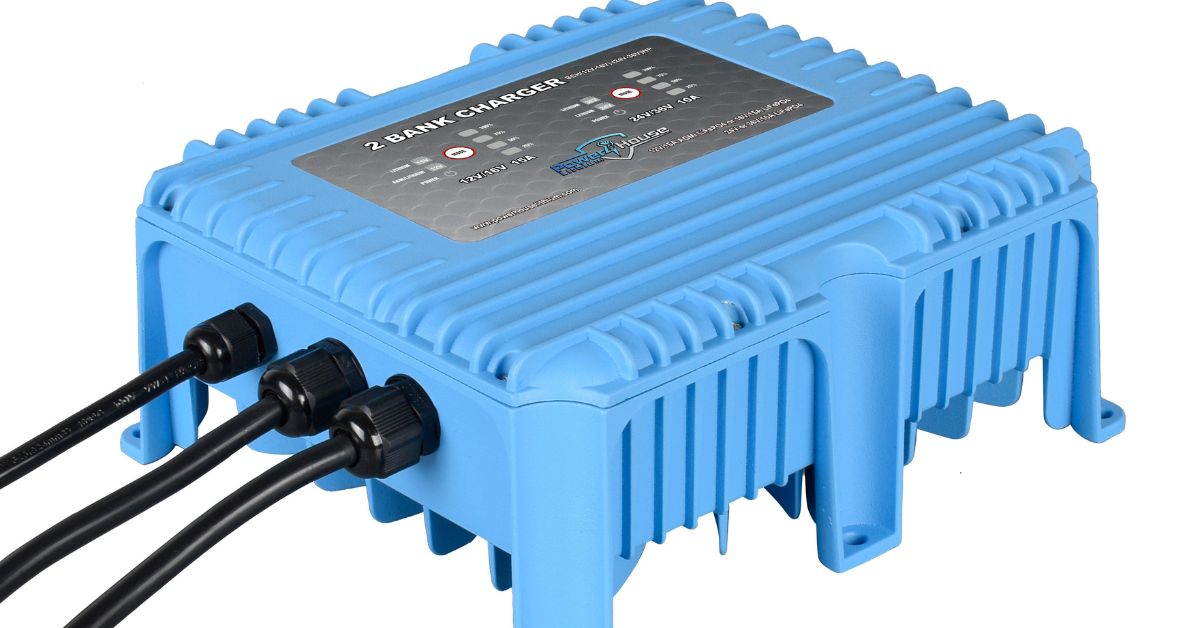Boat days are sacred. Whether you’re chasing difficult catches at sunrise or just floating to relax, downtime because of battery issues is the last thing anyone wants. Charging systems aren’t flashy, but they’re the heartbeat of your setup—especially if you’ve gone all-in on lithium.
Boat owners who’ve upgraded to lithium batteries already know the performance jump is real. But even the best battery bank in the world won’t do much without the right charger. That’s where the decision gets tricky—how do you choose between 2-bank and 3-bank chargers for your boat?
This post breaks it all down. No jargon, no fluff—just solid, water-tested advice from someone who gets it.
What Do “Bank Chargers” Actually Do?
Multi-bank chargers let you charge multiple batteries independently from a single unit. Each bank is a separate charging circuit that manages one battery or a group wired in parallel.
So, if your boat has a starting battery, a trolling motor battery, and a house battery, you’re juggling three different power needs. A multi-bank charger simplifies this by feeding all of them juice at once—no plug juggling, no switching terminals.
The Case for a 2-Bank Charger
Let’s start with the 2-bank charger. These are perfect for setups where you’ve only got two distinct battery roles—maybe one for cranking the outboard and another for your trolling motor or electronics.
Ideal Setup
- One starting battery
- One deep-cycle or lithium trolling battery
This setup keeps things simple. Two banks mean fewer connections and often less space taken up by the charger. If your boat is on the smaller side or you have a lean electrical setup, this could be all you need.
Pros
- Smaller footprint
- Easier installation
- Less wiring clutter
Things To Consider
- No flexibility to add a third battery later
- The risk of undercharging batteries on the same circuit
If your setup is tight and you’re confident you won’t be adding a third battery anytime soon, a 2-bank charger can be a smart, efficient choice.

Why a 3-Bank Charger Might Be a Game Changer
As soon as you introduce a third battery—maybe one for electronics, livewells, or lighting—it’s time to think bigger. A 3-bank charger covers more ground, and if your boat’s running a serious setup, it’s often the better long-term call.
Typical 3-Bank Layout
- One battery for starting
- One for your trolling motor
- One house/electronics battery
This separation is vital for keeping your systems stable. You don’t want your trolling motor draining your fishfinder’s battery. And you definitely don’t want your fridge cutting off halfway through a long day on the water because everything’s on one circuit.
Pros
- Full battery isolation during charging
- More control over each battery type
- Room for system expansion later
Things To Watch Out For
- Higher initial costs
- Higher space demands
- A more complex installation process on some boats
Still, most modern boats—especially those running lithium setups—are better off with the flexibility of a 3-bank charger.
Matching Your Charger to Lithium Batteries
Lithium batteries are picky—in a good way. They charge faster and last longer, but only if your charger is smart enough to handle them. You’ll want to make sure whatever charger you’re installing is compatible with lithium profiles.
A lot of newer models support lithium out of the box, and the good ones let you program or auto-detect battery type. Bonus points if you’re running a DC-to-DC charger for lithium batteries while underway, as that’ll keep your house batteries topped off even while you’re motoring.
Never assume your old charger will play nice with lithium just because it worked fine with lead-acid. Double-check the specs or you’ll end up with batteries that aren’t fully charged—or worse, damaged over time.

Space, Budget, and Future-Proofing
Not every boat has the same space below deck. If you’re fishing out of a compact bass boat, space-saving gear matters. A 2-bank charger might tuck away nicely where a 3-bank unit won’t. But if you’ve got the room, that third bank gives you some breathing space—not just physically, but mentally.
And think long term. You might only have two batteries now, but are you planning on adding electronics, a livewell, or another accessory that could justify a third battery? Investing in a 3-bank charger now saves you from another install later.
Also, weigh the price difference realistically. In most cases, the price bump between 2-bank and 3-bank chargers isn’t huge. When you stack that up against the cost of your batteries—or worse, missing a fishing weekend because something didn’t charge—it’s usually worth it.
Installation Tips
There are a few key steps to take when installing either charger:
- Mount your charger in a dry, ventilated spot.
- Use marine-grade wiring and connections.
- Keep wires short and direct—less resistance means faster charging.
- Label your battery banks clearly.
Finally, you should always follow the manufacturer’s installation instructions. Even if you’ve wired dozens of boats, every charger has its quirks.
What Other Boaters Are Choosing
If you hang around enough marinas or boat ramps, you’ll start seeing a trend—many folks lean toward 3-bank chargers, especially those running electronics-heavy setups or fishing tournaments.
They’re not doing it for fun. They’re doing it because consistent charging means more time on the water and fewer headaches between trips.
That said, plenty of anglers with simple setups swear by 2-bank chargers and haven’t run into a single problem.
It all comes down to how you boat, how you fish, and how much gear you’re running.
Final Thoughts: Choose What Keeps You on the Water
Choosing the right charger setup shouldn’t be stressful. You’re not wiring up a spaceship—you’re making sure your batteries are ready when you are.
If you’re keeping things simple with a starting and trolling battery, a 2-bank charger may be all you ever need. But if you’ve got a third battery—or might add one later—a 3-bank charger is the way to go.
At the end of the day, choose between 2-bank and 3-bank chargers for your boat based on what’s going to keep your systems running. The fish don’t care how many batteries you have—but they will notice if your trolling motor dies halfway through the drift.

